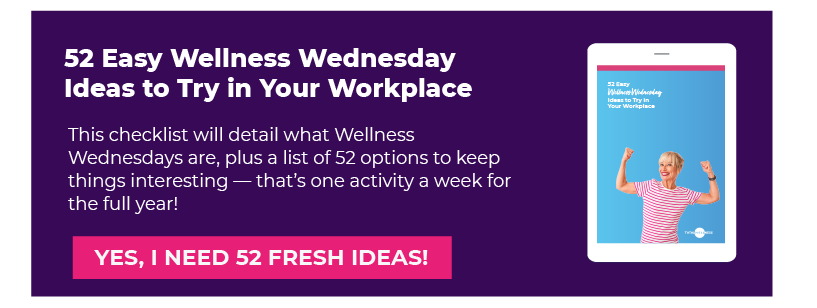 Wellness privilege…what exactly is it?
Wellness privilege…what exactly is it?
It’s no secret some people have much better access to improve their health and well-being than others.
Sure, we all know it’s a healthy choice to eat well, skip smoking, and exercise regularly. Yet how many individuals truly have the tools to do all three and then some in the name of optimal health?
For some, even the most basic of wellness activities aren’t within reach because of societal inequities and the cost of implementing healthy habits.
Look at any low-income areas and it’s easy to see there are more fast food joints than farmers' markets. Take a drive through an affluent neighborhood, and you’ll no doubt see gyms, juice bars, and wellness centers on nearly every corner.
Simply put, being healthy isn’t always an attainable, simple choice. In fact, it’s a term called a wellness privilege.
Below, you’ll learn more about what wellness privilege is, why how you market workplace wellness campaigns matters, and how to better approach well-being at work to focus on giving your employees a more inclusive wellness experience.
What is Wellness Privilege?
Doesn’t achieving optimal health include strict diets, exercise routines, and also include a myriad of supplements, meetings with nutritionists, daily sessions with a personal trainer, and more?
For many, that’s unattainable. It’s not even an option. Ongoing, easy access to those types of services and well-being products is called wellness privilege.
By definition, privilege is a “special right, advantage, or immunity granted or available only to a particular person or group.” Wellness privilege, on the other hand, includes access to physical, emotional, social, financial, and community sense of well-being.
For some people, it’s much easier to access wellness services. For example, someone in a more affluent area with a well-paying job may use the regular services of a personal trainer or nutritionist. Compared to someone in a low-income neighborhood, the idea of putting even a healthy meal on the table may seem trying and unattainable.
Wellness privilege can look like being able to take exercise breaks at work, access to an on-site work gym, shorter commutes (or no commute), and more.
The more access you have to wellness privilege and its resources, the more likely you’ll thrive personally, professionally, and otherwise.
Why It Matters in the Workplace
Even if your company has a fantastic wellness program, how it’s being marketed and offered can have an air of wellness privilege to it. If certain employees feel they’re being left out, it can have a negative psychological impact as a sense of belonging matters for overall well-being, too.
Those who are left out may experience negative mental health concerns like anxiety and depression, according to one research paper recently published on The London School of Economics and Political Science website.
Inclusive well-being in the workplace means equally catering to employees when it comes to resources, challenges, benefits, and beyond. What’s available to C-suite executives should also be available to entry-level employees in a company when it comes to wellness offerings.
How to Approach Wellness Privilege at Work
The global health and wellness industry was worth about 3.2 billion in 2021. In a world where the hottest juice cleanses, best workout classes, top-notch gear, and more are glorified as the only way to be healthy, it can be easy to let that toxic mindset seep into the workplace.
Instead, meet your workers where they are at in their wellness journey. Healthy living is an individual choice and process. Are there changes leadership or wellness committees can take to create more wellness privilege in the workplace?
Here’s a look at how to approach wellness with your employees and wellness committees in a healthy, less judgmental way at work:
- Acknowledge - Not everyone wants to or has the time to dedicate to a juice cleanse or 50-minute spin sessions or hot yoga classes every day. When creating wellness programs and campaigns, think of your audience. Survey them, ask them what they actually need and want to learn about when it comes to wellness. What would truly help them? Acknowledge that everyone has a different background when it comes to wellness exploration.
- Recognize the wellness burden - Being a human is hard. Navigating life without valuable tools like therapy or journaling can be difficult for those who deal with past trauma, mental health issues, and other emotional challenges. But when those tools are available, it makes it easier to work through problems, be resilient, and feel less anxious. But all those wellness tools also cost money and a lot of people don’t have extra time or funds to devote to that. As a workplace, look at ways that helpful wellness options can be offered. Free, low-cost, sliding scale options can be presented to workers as a way to create their own well-being journey on their terms.
- Offer empathy and awareness - Learning to practice empathy and awareness that not everyone has the same knowledge or experiences surrounding wellness is a starting point, especially for workplace wellness committees creating programs.
- Is there equal access? - Don’t let a power divide pop up between those with disabilities and healthy workers. If there’s a chance someone could fall behind on a wellness challenge due to a disability, for example, it’s important to think of ways to even the playing field for them in a way that’s respectful.
- Get personal - Instead of focusing on specific health outcomes for a group of workers, allow employees to set personalized health goals for wellness challenges. This makes it personal and more motivating as it allows individual workers to focus on what’s most important to their health journey — not what society or a wellness committee says is most important to focus on.
- Be wary of diet culture - Yes, being at a healthy weight is ideal for good health. But remember it can be toxic to tout too much of diet culture, especially in wellness challenges. It can be very consumerist-based and commercialized about investing in diet pills, cleanses, specific fitness routines or classes, etc. Encourage what’s within reach for your employees. Ask them about ways they could see themselves investing in a healthier diet and routine.
Wellness looks different for everyone. It doesn’t have to cost exorbitant amounts of money to feel good or live a good life. As a company, if you can offer special perks like discounted gym memberships, an on-site gym, or employee access to a counselor, offer those to workers. In doing so, you give them an opportunity to explore the best wellness path for themselves.
What does wellness privilege mean to you? Share your thoughts in the comments below.



